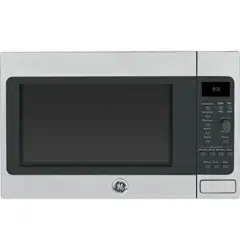Documents: Go to download!
User Manual
- User Manual - (English, Spanish)
- Quick specs - (English)
- About the features of your oven.
- About the cooking features of your microwave/convection oven.
- Available cooking options.
- About the time and auto microwave features.
- About changing the power level
- About the sensor microwave features.
- About the convection features.
- About the combination features.
- Cookware tips
- Select the best method of cooking.
- About the other features.
- Microwave terms.
- Care and cleaning of the oven.
- Before you call for service - Troubleshooting Tips
Table of contents
User manual Microwave Oven for models: CEB1590*, PEB1590*, PEB9159*.
MFL38211620 49-40658-2 11-14 GE
About the features of your oven.
Throughout this manual, features and appearance may vary from your model.
1000 Watts

Features of the Oven
 Door Latch Release Handle.
Door Latch Release Handle.
 Door Latches.
Door Latches.
 Window with Metal Shield. Screen allows cooking to be viewed while keeping microwaves confined in the oven.
Window with Metal Shield. Screen allows cooking to be viewed while keeping microwaves confined in the oven.
 Control Panel and Selector Dial.
Control Panel and Selector Dial.
 Removable Turntable. Turntable and support must be in place when using the oven. The turntable may be removed for cleaning.
Removable Turntable. Turntable and support must be in place when using the oven. The turntable may be removed for cleaning.
 Removable Turntable Support. The turntable support must be in place when using the oven.
Removable Turntable Support. The turntable support must be in place when using the oven.
 Shelf. Use when convection or combination cooking. (Do not use when microwave cooking.)
Shelf. Use when convection or combination cooking. (Do not use when microwave cooking.)
About the cooking features of your microwave/convection oven.
You can cook by microwave, convection or combination.

Cooking Controls
 Microwave Cooking Time and Auto Features
Microwave Cooking Time and Auto Features

 Convection Cooking
Convection Cooking

 Combination Cooking
Combination Cooking

Available cooking options.
Microwave Cooking
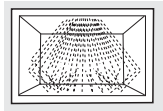
Your oven uses microwave energy to cook by a set time or weight, or automatically by sensor.
Sensor microwave works by detecting the increasing humidity released during cooking.
The oven automatically adjusts the cooking time to various types and amounts of food
Cooking Method
Microwave energy is distributed evenly throughout the oven for thorough, fast cooking of food.
Heat Source
Microwave energy.
Heat Conduction
Heat produced within food by instant energy penetration.
Benefits
Fast, high efficiency cooking. Oven and surroundings do not get hot. Easy clean-up.
Convection Cooking
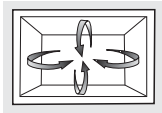
During convection cooking, a heating element is used to raise the temperature of the air inside the oven.
Any oven temperature from 225°F to 450°F may be programmed. A fan gently circulates this heated air throughout the oven, over and around the food, producing golden brown exteriors and rich moist interiors.
Because the heated air is kept constantly moving, not permitting a layer of cooler air to develop around the food; some foods cook faster than in regular oven cooking.
Cooking Method: Hot air circulates around food to produce browned exteriors and seal in juices.
Heat Source: Circulating heated air.
Heat Conduction: Heat conducted from outside of food to inside.
Benefits: Aids in browning and seals in flavor. Cooks some foods faster than regular ovens.
Combination Cooking
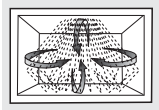
Your oven also offers the option of combination cooking, using microwave energy along with convection cooking. You cook with speed and accuracy, while browning and crisping to perfection.
Cooking Method: Microwave energy and convection heat combine to cook foods in up to one-half the time of regular ovens, while browning and sealing in juices.
Heat Source: Microwave energy and circulating heated air.
Heat Conduction: Food heats from instant energy from penetration and heat conducted from outside of food.
Benefits: Shortened cooking time from microwave energy, plus browning and crisping from convection heat.
About the time and auto microwave features.
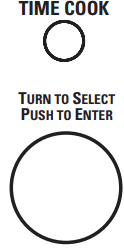
Time Cook
Time Cook I
Allows you to microwave for any time between 15 seconds and 95 minutes.
Power level 10 (High) is automatically set, but you may change it for more flexibility.
- Press the TIME COOK button.
- Turn the dial to set the cook time and press the dial to enter.
- Change power level if you don’t want full power. (Press POWER. Turn the dial to select. Press the dial to enter.)
- Press the START/PAUSE button to start cooking.
You may open the door during Time cook to check the food. Close the door and press START/ PAUSE to resume cooking.
Time Cook II
Lets you change power levels automatically during cooking. Here’s how to do it:
- Press the TIME COOK button.
- Turn the dial to set the first cook time and press the dial to enter.
- Change the power level if you don’t want full power. (Press POWER. Turn the dial to select. Press the dial to enter.)
- Press the TIME COOK button again.
- Turn the dial to set the second cook time and press the dial to enter.
- Change the power level if you don’t want full power. (Press POWER. Turn the dial to select. Press the dial to enter.)
- Press the START/PAUSE button to start cooking.
At the end of Time Cook I, Time Cook II counts down.
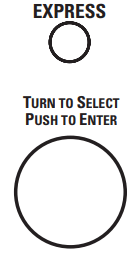
Express Cook
This is a quick way to set and start cooking in 30 second blocks each time the EXPRESS button is pressed.
The power level will automatically be set at 10 and the oven will start immediately.
The power level can be changed as time is counting down. Press the POWER button, turn the dial and press to enter.

Add 30 Seconds
Each time the EXPRESS button is pressed, it will add 30 seconds to any cooking time counting down, until the maximum cooking time is reached.
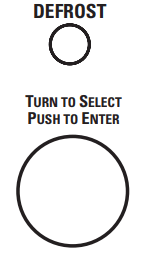
Time Defrost
Use Time Defrost to defrost for a selected length of time.
- Press the DEFROST button.
- Turn the dial to select the time you want. Press the dial to enter.
- Press the START/PAUSE button to start defrosting.
- Turn the food over if the oven signals TURN FOOD OVER.
Power level is automatically set at 3, but can be changed. You can defrost small items quickly by raising the power level after entering the time. Power level 7 cuts the total defrosting time in about half; power level 10 cuts the total time to approximately 1/3. However, food will need more frequent attention than usual.
A dull thumping noise may be heard during defrosting. This is normal when oven is not operating at High power.
Defrosting Tips
- Foods frozen in paper or plastic can be defrosted in the package. Closed packages should be slit, pierced or vented AFTER food has partially defrosted. Plastic storage containers should be partially uncovered.
- Family-size, prepackaged frozen dinners can be defrosted and microwaved. If the food is in a foil container, transfer it to a microwave-safe dish.
- Foods that spoil easily should not be allowed to sit out for more than one hour after defrosting. Room temperature promotes the growth of harmful bacteria.
- For more even defrosting of larger foods, such as roasts, use Auto Defrost. Be sure large meats are completely defrosted before cooking.
- When defrosted, food should be cool but softened in all areas. If still slightly icy, return to the microwave very briefly, or let it stand a few minutes.
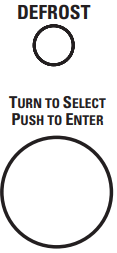
Auto Defrost
Use Auto Defrost for meat, poultry and fish. Use Time Defrost for most other frozen foods.
Auto Defrost automatically sets the defrosting times and power levels to give even defrosting results for meats, poultry and fish.
- Remove meat from package and place on microwave-safe dish.
- Press the DEFROST button twice.
- Turn the dial to the food weight, using the Conversion Guide at right. For example, dial 1.2 for 1.2 pounds (1 pound, 3 oz.). Press the dial to enter.
- Press the START/PAUSE button to start defrosting.
- Turn the food over if the oven signals TURN FOOD OVER.
- Remove defrosted meat or shield warm areas with small pieces of foil.
- After defrosting, most meats need to stand 5 minutes to complete defrosting. Large roasts should stand for about 30 minutes.
Conversion Guide
If the weight of food is stated in pounds and ounces, the ounces must be converted to tenths (.1) of a pound.
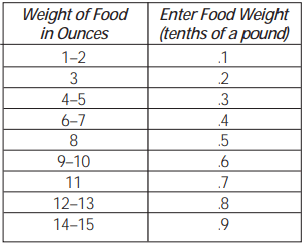
About changing the power level
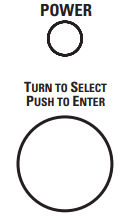
The power level may be entered or changed immediately after entering the time for Time Cook, Time Defrost or Express Cook. The power level may also be changed during time countdown.
- First, follow directions for Time Cook, Time Defrost or Express Cook.
- Press the POWER button.
- Turn the dial clockwise to increase and counterclockwise to decrease the power level. Press the dial to enter.
- Press the START/PAUSE button to start cooking.
Variable power levels add flexibility to microwave cooking. The power levels on the microwave oven can be compared to the surface units on a range. Each power level gives you microwave energy a certain percent of the time. Power level 7 is microwave energy 70% of the time. Power level 3 is energy 30% of the time. Most cooking will be done on High (power level 10) which gives you 100% power. Power level 10 will cook faster but food may need more frequent stirring, rotating or turning over. A lower setting will cook more evenly and need less stirring or rotating of the food. Some foods may have better flavor, texture or appearance if one of the lower settings is used. Use a lower power level when cooking foods that have a tendency to boil over, such as scalloped potatoes.
Rest periods (when the microwave energy cycles off) give time for the food to “equalize” or transfer heat to the inside of the food. An example of this is shown with power level 3- the defrost cycle. If microwave energy did not cycle off, the outside of the food would cook before the inside was defrosted.
Here are some examples of uses for various power levels:
High 10: Fish, bacon, vegetables, boiling liquids.
Med-High 7: Gentle cooking of meat and poultry; baking casseroles and reheating.
Medium 5: Slow cooking and tenderizing for stews and less tender cuts of meat.
Low 2 or 3: Defrosting; simmering; delicate sauces.
Warm 1: Keeping food warm; softening butter.
About the sensor microwave features.
Humidity Sensor
The Sensor Features detect the increasing humidity released during cooking. The oven automatically adjusts the cooking time to various types and amounts of food.
Do not use the Senser Feature twice in succession on the same food portion - it may result in severely overcooked or burnt food. If food is under cooked after the countdown, use Time Cook for additional cooking time.
- The proper containers and covers are essential for best sensor cooking.
- Always use microwave-safe containers and cover them with lids or vented plastic wrap. Never use tight sealing plastic containers - thay can prevent steam from escaping and case food to overcook.
- Be sure the outside of the cooking containers and the inside of the microwave oven are dry before placing food in the oven. Beads of moisture turning into steam can mislead the sensor.
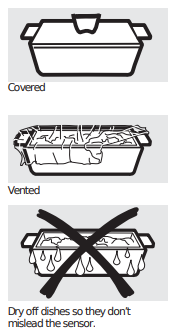
Cook

Because most cooking containers must be covered during Cook, this feature is best with foods that you want to steam or retain moisture.
NOTE: Use of the metal shelf with Cook is not recommended.
Recommended Foods
A wide variety of foods including meats, fish and vegetables can be cooked using this feature.
Foods not recommended
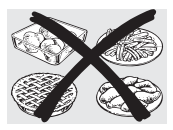
Foods that must be cooked uncovered, foods that require constant attention, foods that require addition of ingredients during cooking and foods calling for a dry look or crisp surface after cooking should not be cooked using this feature. It is best to Time Cook them.
Cook

NOTE: Do not use this feature twice in succession on the same food portion - it may result in severely overcooked or burnt food.
- Place covered food in the oven and close the door. Press the COOK button. SELECT FOOD TYPE appears in the display.
- Place covered food in the oven and close the door. Press the COOK button. SELECT FOOD TYPE appears in the display.
The oven starts immediately.
NOTE: If the door was open while the control was being set, close the door and press the START/ PAUSE button to begin cooking.
Do not open the oven door before the countdown time is displayed - steam escaping from the oven can affect cooking performance. If the door is opened, close the door and press START/PAUSE immediately.
If ground meat was selected, the oven may signal you to drain and stir the meat. Open the door, drain the meat and close the door. Press the START/ PAUSE button if necessary to resume cooking.
If food is under cooked after the countdown use Time Cook for additional cooking time.
Cooking Tips
- When oven signals and countdown time is displayed, the door may be opened for stirring, turning or rotating food. To resume cooking, close the door and press START/PAUSE.
- Match the amount of food to the size of container. Fill containers at least 1/2 full.
- Be sure outside of container and inside of oven are dry.
- After completion of Cook cycle, if food needs additional cooking, return food to oven and use Time Cook to finish cooking.
How to Adjust the Oven’s Automatic Settings for a Shorter or Longer Cook Time (Not available for all food types)
To subtract 10% from the automatic cooking time: Immediately after the oven starts, turn the dial counterclockwise and press to enter.
To add 10% to the automatic cooking time: Immediately after the oven starts, turn the dial clockwise and press to enter.

Popcorn

NOTE: Do not use this feature twice in succession on the same food portion - it may result in severely overcooked or burnt food.
To use the Popcorn feature:
- Follow package instructions, using Time Cook if the package is less than 1.5 ounces or larger than 3.5 ounces. Place the package of popcorn in the center of the microwave.
- Press the POPCORN button once or twice. The oven starts immediately.
Press once for a regular size (3.0 to 3.5 oz.) bag of popcorn.
Press twice for a snack size (1.5 to 1.75 oz.) bag of popcorn.
If you open the door while POPCORN is displayed, an error message will appear. Close the door, press OFF/CLEAR and begin again.
If food is undercooked after the countdown, use Time Cook for additional cooking time.
How to Adjust the Automatic Popcorn Setting to Provide a Shorter or Longer Cook Time
If you find that the brand of popcorn you use underpops or overpops consistently, you can add or subtract 20–30 seconds to the automatic popping time.
To subtract time: Immediately after the oven starts, turn the dial counterclockwise for 20 seconds (-) less cooking time. Press to enter. Turn again to reduce cooking time another 10 seconds (- -) total 30 seconds less time. Press to enter.
To add time: Immediately after the oven starts, turn the dial clockwise for an extra 20 seconds (+) cooking time. Press to enter. Turn again to add another 10 seconds (++) total 30 seconds additional time. Press to enter.
Reheat

NOTE: Do not use this feature twice in succession on the same food portion - it may result in severely overcooked or burnt food.
The Reheat feature reheats servings of previously cooked foods or a plate of leftovers.
1. Place the cup of liquid or covered food in the oven. Press REHEAT once, twice or three times. The oven starts immediately.
Press once for 1/2 to 1 full cup.
Press twice for 1 to 2 full cups.
Press three times for a plate of leftovers.
2. The oven signals when steam is sensed and the time remaining begins counting down.
Do not open the oven door until time is counting down. If the door is opened, close it and press START immediately.
After removing food from the oven, stir, if possible, to even out the temperature. Reheated foods may have wide variations in temperature. Some areas of food may be extremely hot.
If food is not hot enough after the countdown, use Time Cook for additional reheating time.
Some Foods Not Recommended for Use With Reheat
It is best to use Time Cook for these foods:
- Bread products.
- Foods that must be reheated uncovered.
- Foods that need to be stirred or rotated.
- Foods calling for a dry look or crisp surface after reheating.
How to Adjust the Oven’s Automatic Settings for a Shorter or Longer Time
To subtract 10% from the automatic cooking time: Immediately after the oven starts, turn the dial counterclockwise and press to enter.
To add 10% to the automatic cooking time: Immediately after the oven starts, turn the dial clockwise and press to enter.
Beverage

NOTE: Do not use this feature twice in succession on the same food portion - it may result in severely overcooked or burnt food.
Press the BEVERAGE button to heat an 8–10 oz. cup of coffee or other beverage. The oven starts immediately.
Drinks heated with the Beverage feature may be very hot. Remove the container with care.
If food is undercooked after the countdown, use Time Cook for additional cooking time.
About the convection features.
Convection cooking uses a heating element to raise the temperature of the air inside the oven. Any oven temperature from 225°F to 450°F may be set. A fan gently circulates this heated air throughout the oven, over and around the food, producing golden brown exteriors and rich, moist interiors.
Because the heated air is kept constantly moving, not permitting a layer of cooler air to develop around the food, some foods cook faster than in regular oven cooking.
See the Cookware Tips section for information on suggested cookware.
For Best Results…
Always use the shelf when convection cooking.
Reduce package/recipe temperature 25°F for baked goods.
The shelf is required for good air circulation and even browning.
See the Cookware Tips section for information on suggested cookware.
Convection Time Cook with Preheat
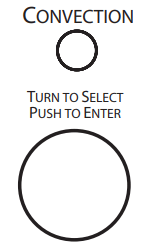
- Press the CONVECTION button.
- Turn the dial to set the oven temperature and press dial to enter preheating. Do not enter convection cook time now. (The cook time will be entered later, after the oven is preheated.)
- Press the START/PAUSE button to start preheating.
- When the oven is preheated, it will signal. If you do not open the door within 1 hour, the oven will turn off automatically.
- Open the oven door and, using caution, place the food in the oven.
- Close the oven door. Turn the dial to set the cook time and press START/PAUSE to start cooking.
- When cooking is complete, the oven will signal and turn off.
Convection Time Cook without Preheating

- If your recipe does not require preheating, press the CONVECTION button.
- Turn the dial to set the oven temperature and press to enter.
- Turn the dial to set the cook time and press to enter.
- Press the START/PAUSE button to start the oven.
About the combination features.
Combination Cooking offers the best features of microwave energy and convection cooking. Microwaves cook food fast and convection circulation of heated air browns foods beautifully. Any oven temperature from 225°F to 450°F may be set.
For Best Results…
Always use the shelf when combination cooking.
The shelf is required for good air circulation and even browning.
See the Cookware Tips section for information on suggested cookware.
Combination Time Cooking with Preheat
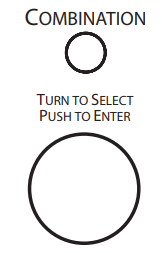
- Press the COMBINATION button.
- Turn the dial to set the oven temperature and press dial to enter preheating. Do not enter combination cook time now. (The cook time will be entered later, after the oven is preheated.)
- Press the START/PAUSE button to start preheating.
- When the oven is preheated, it will signal. If you do not open the door within 1 hour, the oven will turn off automatically.
- Open the oven door and, using caution, place the food in the oven.
- Close the oven door. Turn the dial to set the cook time and press to enter. Press the START/ PAUSE button to start cooking.
- When cooking is complete, the oven will signal and turn off.
Combination Time Cooking without Preheat

- If your recipe does not require preheating, press the COMBINATION button.
- Turn the dial to set the oven temperature and press to enter.
- Turn the dial to set the cook time and press to enter.
- Press the START/PAUSE button to start the oven.
NOTE:
- Some recipes call for preheating.
- Check the Cookware Tips section for correct cookware when Combination Cooking.
- Do not use metal cookware when Combination Cooking.
- Place meat on a trivet in a glass dish to collect juices and prevent spattering.
- For best roasting and browning results, whole roasts should be cooked in a glass dish placed directly on the oven shelf.
- For foods that are too tall to fit in the oven, you can leave out the trivet. If necessary, you may take out the shelf and place the dish directly on the turntable.
Cookware tips
Convection Cooking
Metal Pans are recommended for all types of baked products, but especially where browning or crusting is important.
Dark or dull finish metal pans are best for breads and pies because they absorb heat and produce crisper crust.
Shiny aluminum pans are better for cakes, cookies or muffins because these pans reflect heat and help produce a light tender crust.
Glass or Glass-Ceramic casserole or baking dishes are best suited for egg and cheese recipes due to the cleanability of glass.
Combination Cooking
Glass or Glass-Ceramic baking containers are recommended. Be sure not to use items with metal trim as it may cause arcing (sparking) with oven wall or oven shelf, damaging the cookware, the shelf or the oven.
Heat-Resistant Plastic microwave cookware (safe to 450°F) may be used, but it is not recommended for foods requiring crusting or all-around browning, because the plastic is a poor conductor of heat.
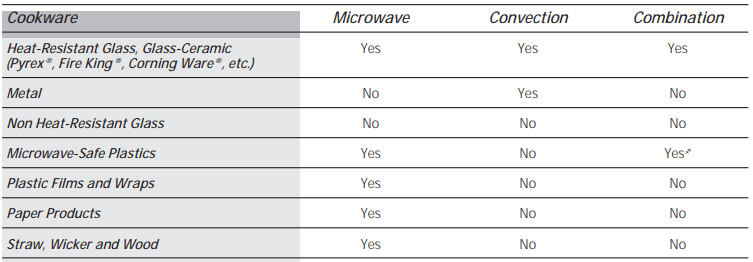
Use only microwave cookware that is safe to 450qF.
Select the best method of cooking.
Use the following guide to select the best method of cooking. Specific recipes can be adapted to any method of cooking
(1) Best method
(2) Alternate method
N/R Not recommended
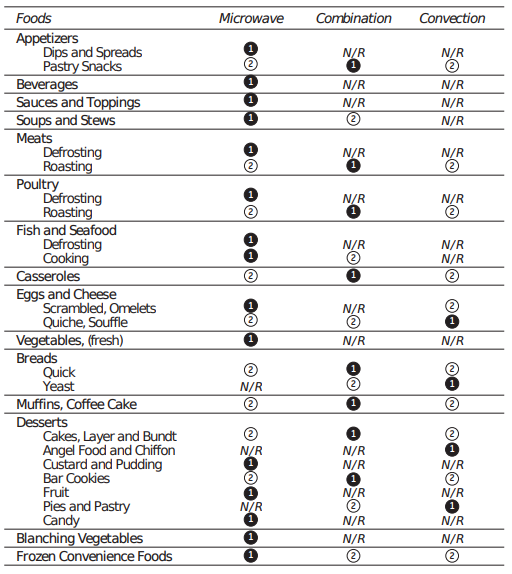
About the other features.
Cooking Complete Reminder
To remind you that you have food in the oven, the oven will display YOUR FOOD IS READY and beep once a minute until you either open the oven door or press the OFF/CLEAR button.
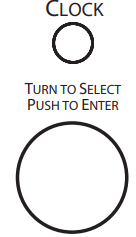
Clock
Press to enter the time of day or to check the time of day while cooking.
- Press the CLOCK button.
- Turn the dial to set hours. Press the dial to enter.
- Turn the dial to set minutes. Press the dial to enter.
- Turn the dial to select AM or PM. Press the dial to enter.
- Press the START/PAUSE button to start the clock.
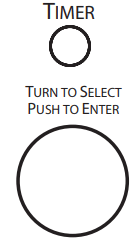
Timer
The Timer operates as a minute timer and can be used at any time, even when the oven is operating.
- Press the TIMER button.
- Turn the dial to select the minutes. Press the dial to enter.
- Turn the dial to select the seconds. Press the dial to enter.
- Press TIMER to start.
To pause, press TIMER. To restart, press TIMER again.
To cancel, press and hold the TIMER button down for about 2 seconds.
When time is up, the oven will signal. To turn off the timer signal, press TIMER.
NOTE: The timer indicator will be lit while the timer is operating.
Start/Pause
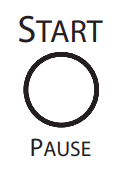
In addition to starting many functions, START/ PAUSE allows you to stop cooking without opening the door or clearing the display
Off/Clear
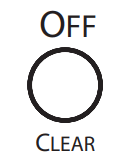
Press the OFF/CLEAR button to stop and cancel cooking at any time.
Control Lock-Out
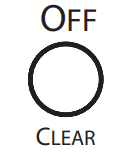
You may lock the control panel to prevent the oven from being accidentally started or used by children.
To lock or unlock the controls, press and hold the OFF/CLEAR button for about three seconds. When the control panel is locked, CONTROL LOCKED will be displayed briefly anytime a button or dial is pressed.
Beeper Volume
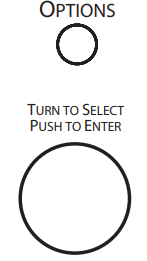
The beeper sound level can be adjusted. Press the OPTIONS button once and turn the dial to select TURN TO SELECT mute to loud. Press the dial to enter.
Display ON/OFF
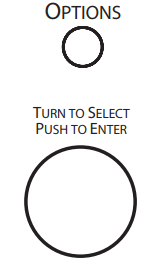
Use to turn your clock display on or off. Press the OPTIONS button twice and turn the dial to select ON or OFF. Press the dial to enter
Display Speed
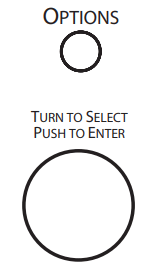
The scroll speed of the display can be changed. Press the OPTIONS button three times and turn the dial to select slowest to fastest. Press the dial to enter.
Microwave terms.
Term | Definition |
| Arcing | Arcing is the microwave term for sparks in the oven. Arcing is caused by:
|
| Covering | Covers hold in moisture, allow for more even heating and reduce cooking time. Venting plastic wrap or covering with wax paper allows excess steam to escape. |
| Shielding | In a regular oven, you shield chicken breasts or baked foods to prevent over-browning. When microwaving, you use small strips of foil to shield thin parts, such as the tips of wings and legs on poultry, which would cook before larger parts. |
| Standing Time | When you cook with regular ovens, foods such as roasts or cakes are allowed to stand to finish cooking or to set. Standing time is especially important in microwave cooking. Note that a microwaved cake is not placed on a cooling rack. |
| Venting | After covering a dish with plastic wrap, you vent the plastic wrap by turning back one corner so excess steam can escape. |
Care and cleaning of the oven.
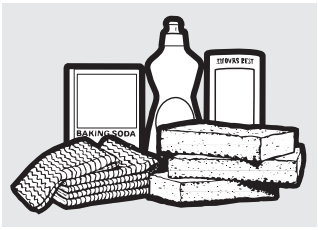
Helpful Hints
An occasional thorough wiping with a solution of baking soda and water keeps the inside fresh.
Unplug the cord before cleaning any part of this oven.
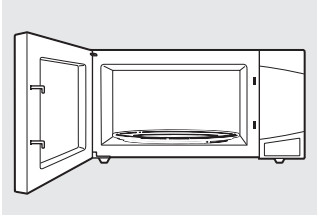
How to Clean the Inside
Walls, Floor, Inside Window, Metal and Plastic Parts on the Door
Some spatters can be removed with a paper towel, others may require a damp cloth. Remove greasy spatters with a sudsy cloth, then rinse with a damp cloth. Do not use abrasive cleaners or sharp utensils on oven walls.
To clean the surface of the door and the surface of the oven that come together upon closing, use only mild, non-abrasive soaps or detergents using a sponge or soft cloth. Rinse with a damp cloth and dry.
Never use a commercial oven cleaner on any part of your microwave.

Removable Turntable and Turntable Support
To prevent breakage, do not place the turntable into water just after cooking. Wash it carefully in warm, sudsy water or in the dishwasher. The turntable and support can be broken if dropped. Remember, do not operate the oven without the turntable and support in place.
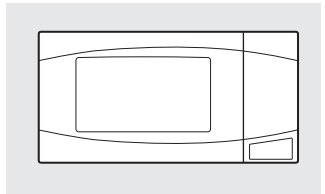
How to Clean the Outside
Do not use cleaners containing ammonia or alcohol on the microwave oven. Ammonia or alcohol can damage the appearance of the microwave.
Case
Clean the outside of the microwave with a sudsy cloth. Rinse with a damp cloth and then dry. Wipe the window clean with a damp cloth.
Control Panel and Door
Wipe with a damp cloth. Dry thoroughly. Do not use cleaning sprays, large amounts of soap and water, abrasives or sharp objects on the panel - they can damage it. Some paper towels can also scratch the control panel.
Door Surface
It is important to keep the area clean where the door seals against the microwave. Use only mild, nonabrasive detergents applied with a clean sponge or soft cloth. Rinse well.
Power Cord
If the cord becomes soiled, unplug and wash with a damp cloth. For stubborn spots, sudsy water may be used, but be certain to rinse with a damp cloth and dry thoroughly before plugging cord into outlet.
Stainless Steel
Do not use a steel-wool pad; it will scratch the surface.
To clean stainless steel surfaces, use a hot, damp cloth with a mild detergent suitable for stainless steel surfaces. Use a clean, hot, damp cloth to remove soap. Dry with a dry, clean cloth.
If food soil remains, try a general kitchen cleaner, such as Fantastik®, Simple Green® or Formula 409®.
For hard-to-clean soil, use a standard stainlesssteel cleaner, such as Bon-Ami® or Cameo®.
Apply cleaner with a damp sponge. Use a clean, hot, damp cloth to remove cleaner. Dry with a dry, clean cloth. Always scrub lightly in the direction of the grain.
After cleaning, use a stainless-steel polish, such as Stainless Steel Magic®, Revere Copper and Stainless Steel Cleaner® or Wenol All Purpose Metal Polish®. Follow the product instructions for cleaning the stainless-steel surface.
Before you call for service - Troubleshooting Tips
Save time and money! Review the charts on the following pages first and you may not need to call for service.
Problem | Possible Causes | What To Do |
| Oven will not start | A fuse in your home may be blown or the circuit breaker tripped. | • Replace fuse or reset circuit breaker. |
| Power surge. | • Unplug the microwave oven, then plug it back in. | |
| Plug not fully inserted into wall outlet. | • Make sure the 3-prong plug on the oven is fully inserted into wall outlet | |
| Door not securely closed. | • Open the door and close securely | |
| Control panel lighted, yet oven will not start | Door not securely closed. | • Open the door and close securely. |
| START button not pressed after entering cooking selection. | • Press START. | |
| Another selection entered already in oven and OFF/CLEAR button not pressed to cancel it | • Press OFF/CLEAR. | |
| Cooking time not entered after pressing TIME COOK. | • Make sure you have entered cooking time after pressing TIME COOK. | |
| OFF/CLEAR was pressed accidentally. | • Reset cooking program and press START | |
| Food weight not entered after selecting AUTO DEFROST. | • Make sure you have entered food weight after selecting AUTO DEFROST. | |
| Food type not entered after pressing COOK. | • Make sure you have entered a food type. | |
| CONTROL LOCKED appears on display | The control has been locked. | • Press and hold OFF/CLEAR for about 3 seconds to unlock the control. |
| CAUTION -OVEN HOT appears on display | The temperature inside the oven is greater than 200°F. | • This is normal. |
| One of the sensor cooking pads was pressed when the temperature inside the oven was greater than 200°F. | • These features will not operate when the oven is hot |
Things That Are Normal With Your Microwave Oven
- Steam or vapor escaping from around the door.
- Light reflection around door or outer case.
- Dimming oven light and change in the blower sound at power levels other than high.
- Dull thumping sound while oven is operating.
- TV/radio interference might be noticed while using the microwave. Similar to the interference caused by other small appliances, it does not indicate a problem with the microwave. Plug the microwave into a different electrical circuit, move the radio or TV as far away from the microwave as possible, or check the position and signal of the TV/radio antenna.
See other models: GSD3300K00WW GTS17KBSERWW AZ22E09E4BM1 JTP75CM2CC A3316ABSARBB
